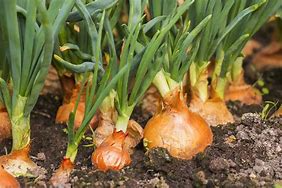“Banish the onion from the kitchen and the pleasure flies with it.” — Elizabeth Robins Pennell
Onions are a cool weather crop and can be planted out in very early spring. They are one of the most versatile plants in the kitchen and easy to grow in the garden.
There are essentially two types of onions: Bulb onions (yellow, red and white onions, and shallots) and onion plants (spring and green onions, and scallion


Benefits and nutritional information:
- Onions contain antioxidants and compounds that fight inflammation, decrease triglycerides and reduce cholesterol levels — all of which may lower heart disease risk.
- Their potent anti-inflammatory properties may also help reduce high blood pressure and protect against blood clots.
- Onions are among the richest food sources of a nutrient called quercetin, which is known to prohibit the activity or creation of cancer-causing elements.
Starting:
- While onions can be started from seeds, most gardeners purchase starts from a nursery or garden center.
- Bulb onions(sets) are the ones that come in a mesh bag and are the size of a quarter. These look like a mini version on the ones you buy at the grocery store.
- These should be planted at least 6” apart in rows 12” to 15” apart.
- Onion varieties tend to be very specific as to where they can be grown successfully.
- Varieties suitable for Eastern Washington won’t always to well here in DuPont.
- Leaving the selection up to the people at the garden center takes the guess-work out of it.
- Onion plants are a in a bundle that look like green onions or scallions. They can be planted 1” to 2” apart. Before planting them work in a couple inches of compost and add some fertilizer.
- Inter-planting onions with tomatoes, carrots, beets, lettuce, and members of the cabbage family gives the added benefit in that onions are pungent and deter pests that might otherwise infest those other crops.
- Avoid planting near beans or peas.
When to plant:
- Because bulb onions take up to 100 days or more to reach harvest size, it's best to plant them from March to early April.
- Onions can also be planted in the late summer or early fall for next year’s har- vest. This allows them to establish a strong root system before winter sets in. As the cold chill of winter arrives, the crop goes dormant. Then, as the temperatures and soil warm again in early spring, the onions come back to life.
- Green onions can be planted later in the season since those begun from starts can generally be harvested in 30 days or so.
- Onions that are over-watered may turn into rotten mush in the soil.
- Onions require nitrogen, but excess levels can delay maturity and lead to shorter storage life.
- It’s recommended that onions receive a dose of a well-balanced fertilizer at the time they’re planted and then again in three months.
Pests and pest controls
- Thrips
- Cut worm, cabbage moth, root maggots
- Rust, downy mildew
- Smut [see section below]
Harvesting
- When bulb onions are mature the foliage will topple over and start to turn yellow. This is when you remove the dirt around the base of the onion and let it begin to dry out.
- A week later on a dry day dig up your onions and place them in the sun. Drying for storage can take any where from 7-14 days.
- Onions should not be stored near potatoes, tomatoes nor most other vegetables since they produce ethylene gas which accelerates ripening of the other crops and quickly causes them to rot.
- For green onions and scallions, once their leaves have reached the size of a pencil you can go ahead and start harvesting.
- The harvesting period can last up until winter, since the plants will keep producing fresh green leaves continuously throughout the season.
Onion Smut
Note the black, dusty lesions along the leaves and bulbs.
Caused by fungi that survive many years in infested soil. They attack only members of the onion family including onions and leeks. Susceptibility decreases as tissue ages. Affected bulbs are predisposed to other infections in storage.
Symptoms
- The disease appears in the plant stem as it emerges.
- Infected areas have a raised, blister-like appearance near ground level.
- Blisters rupture to ex- pose black powdery spore masses.
- Many seedlings die during emergence;
- Those that live produce distorted bulbs with darkish streaks and numerous smutty lesions.
